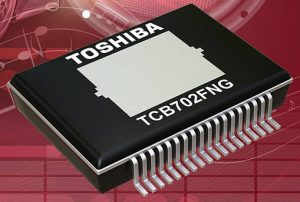Car audio amp spots crossed output connections

Called TCB702FNG, is can be used as a power amplifier or line output amplifier, delivering 45W into a 4Ω load.
“High fidelity output is achieved through a total harmonic distortion of just 0.02% with output noise levels as low as 60 μVrms,” said the firm. Looking at the data sheet, this THD figure is at the low output power of 0.4W, so it applicable to line driving but not loudspeaker driving. One of its extensive list of diagnosis functions is clipping detection, which can be set to THD=2%, 5% or 10% via the chips I2C bus.
Other self-diagnosis function include crossed output connections to detect misconnected loudspeakers, full-time detection of any output dc offsets – preventing speaker burn-out, over-voltage and low-voltage.
Operation is over 6-18V (diagnostics is only specified over 7V, with performance largely specified at 13.2V. 6V operation is supported for compatibility with vehicles that have idling reduction system. ‘Pop’ suppression is included for fluctuating supply voltages.
Packaging is 36pin HSSOP, which is pin-compatible with the company’s earlier TCB701FNG.
For legacy operation there is a non-I2C stand-alone mode which includes diagnostics, but needs a host to interact with two pins to shut the chip down during certain fault conditions.
The firm claims power reduction despite linear operation: “In developing the TCB702FNG, Toshiba has improved on its technology to realise efficiency levels that are comparable with a digital high efficiency, class D amplifier across the actual operating range of 0.5 to 4W. As a result, the power consumption of the new device is reduced by up to 80% when compared to a typical class AB amplifier.”
It calls this operation ‘class TB’ – for ‘tied BTL’, where BTL is short for ‘bridge tied load’ – the ends of the speakers are driven in anti-phase.
According to the data sheet: “The IC operates as the power amplifier mode with high efficiency class TB by setting …. At that time, the output DC voltage of ch1 and ch3 turns to Vcc/4, that of ch2 and ch4 turns to 3Vcc/4.”
Sample shipments have started, and mass production is scheduled to begin in the first quarter of 2019.
